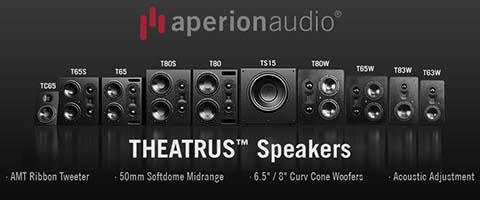By: Ken Humphreys - Speaker Engineer
- - - - - - - - - - - - - - - - - - - - - - - - - - - - - - - - - - - - - - - - - - - - - - - - - - - - - - - - - - - - - - - -
Making Fair Speaker Comparisons

Which speakers should you get? You’ve read all the specs, done your homework memorizing speaker concepts and theory, read tons of reviews, solicited the opinions of friends and scoured the internet. But at the end of the day, the real test is how they sound. Yep, you’re going to have to evaluate them by ear.
But how can anyone be expected to do this intelligently? Trying to evaluate speakers wired up to unfamiliar electronics in an unfamiliar environment that in no way resembles your own can be an exercise in frustration or torture. You don’t know how the electronics are set, what speakers have favorable room placements and what smoke and mirrors the shop employs to make speakers sound better. To make matters worse, you can’t clearly remember what your favorite speaker from the last place sounded like compared to what you’re presently hearing.
Clearly, the best way to do this is to compare the candidates in your own home but a decent showroom can be informative as well. Try to find a small local dealer who knows what they’re doing. A big-box retailer isn’t the place to do this well. What you’re looking for is the opportunity to perform fair, revealing, unhurried, side-by-side speaker comparisons without a sales clerk breathing down your neck with pressure. So we present our ABC’s of how to properly and fairly compare speakers.
- - - - - - - - - - - - - - - - - - - - - - - - - - - - - - - - - - - - - - - - - - - - - - - - - - - - - - - - - - - - - - - -
Setting Everything Up
The first step is to position your speakers where they belong. If you have the manufacturer’s recommendations, use them as a jumping-off point. If not, here are some general rules of thumb:
- Keep them at least 2’ from corners
- Tower speakers go on the floor (naturally!) with their fronts about 2’ from the back wall; small speakers should be at ear-level, often with their backs near a wall.
- Keep the speakers you are about to compare to each other about 6” away from their competition.
If these guidelines end up putting the speakers where you don’t want them, try to find speakers that are designed to work as you’re planning on using them. Set these speakers up as you intend to use them. Grills on or off, aimed straight forward or at the listening area – however you plan on using them is fine. If these any of these choices aren’t important to you, try to set them up as the manufacturer intended.
A few more details and you’ll be ready to start listening. Make sure the receiver is set up with the loudness button (if it has one) turned off, the bass and treble knobs in their neutral positions, the pre-set equalization set to the “flat” option and, if you using a subwoofer, re-set it to where you like it after making these receiver adjustments. If you can’t switch between the speaker candidates, having banana plugs terminating the speaker wires will make it much easier to move wires around.
- - - - - - - - - - - - - - - - - - - - - - - - - - - - - - - - - - - - - - - - - - - - - - - - - - - - - - - - - - - - - - - -
What to Listen To
It’s a good idea to choose some material that represents what you actually listen to — your favorite movies and music. Of course you’ll want to pick some material that pushes the speaker’s limits. It’s fun to listen to those hold-on-to-your-molars action scenes – but in the long run, you’ll appreciate the virtues of great all-around sound more than a speaker’s ability to handle extremes well. Sound that shakes the walls isn’t all that great if every actor sounds like they’re talking through a sock. So don’t overlook the more difficult and subtle task of evaluating the speakers’ sonic chops. To help you out, here are a few of our favorite discs for doing this:
CD’s:
- Norah Jones: Come Away With Me
- Mark Knopfler: Shangra-La
- Donald Fagan: The Cat
- Greg Brown: Confessions
- Ladysmith Black Mambazo: Long Walk to Freedom
- Fritz Reiner: Night on Bald Mountain
- Pink Floyd: Dark Side of the Moon
- AC/DC: Back in Black
- Peter Gabriel: Secret World Live
- Steely Dan: Gaucho
- Jack Johnson: On and On
- Keb-Mo: Slow Down
DVD’s:
- Diane Krall: Live in Paris
- Master & Commander: The Far Side of the World
- The Blue Man Group: Audio
- Hero
- Open Range
- Phantom of the Opera
- Gladiator
- The Incredibles (or anything by Pixar)
- - - - - - - - - - - - - - - - - - - - - - - - - - - - - - - - - - - - - - - - - - - - - - - - - - - - - - - - - - - - - - - -
How To Listen

Listening may seem like a pretty passive act. But, in fact, there’s a lot going on in your brain to make sense of incoming sound. On one hand, this helps you to hear well and distinguish nuance in all manner of sound. On the other, it presents some challenges that need to be respected if you plan on making fair speaker comparisons.
The first among them is that your brain processes loud sounds differently than quiet ones. Since some speakers play louder than others with the same receiver setting, it is very important to adjust the volume knob on your receiver as you go from one speaker to the other so that they play at the same level. This is especially important if you’re using the “A” / “B” buttons on your receiver to toggle between speakers.
Your ears play another “trick” that affects quick side-by-side comparisons. When sound is colored in some way, your ear tries to make it “right” by actively compensating for this flaw. If speaker “A” blasts the treble, your ear will dim the high frequencies a bit. While usually a blessing, this active brain correcting process takes a short while to “un-adjust”. When switching from speaker “A” to speaker “B”, even if “B” is a perfect speaker, it will sound “dull” and deficient in treble for a while. So refrain from making hasty judgments when you first switch to a new speaker. If you’re comparing speakers by disconnecting and reconnecting them, the time required to do so will usually be enough so that you won’t have to worry about this effect. Definitely do not shop for speakers after going to a loud concert.
The next “trick” isn’t so much a “brain-thing,” it’s more of a “human-nature thing.” When selecting speakers you will probably bring along many pre-conceived opinions of what makes a speaker good. Things like speaker size, supposed technological advantages, price or what your know-it-all buddy says about a brand. If you can’t have someone else do the switching or keep your eyes closed, at least try to be conscious and keep an open mind. A lot of your initial sound preferences depend on things other than the speaker’s sound, so bear that in mind when auditioning speakers.
While listening, the right question to ask yourself isn’t “Which speaker sounds the best?” but “Which speaker sounds the most true-to-life?” Don’t strain or listen for too long at a time, take a break every 30 minutes or so.
You’ll find it easy to tell which speaker has the most bass or least treble. But what really matters is balance. Not more than; not less than; but the right amount of. If some of the following descriptors come to mind while you’re listening, there’s likely a balance problem: Boomy, chesty, boxy, hollow, tube-like, honky, nasal, hard, overly present, metallic, sibilant or fizzy. Listen for problems like male voices that sound overly resonant, or too-thin; female voices that lack body, are sizzly or dull. The ability to reveal detail and nuance is important but can be faked by simply boosting the treble – a “solution” that after listening for a while proves less of a solution and more of an irritation.
Rate the bass for definition as well as robustness; the midrange for clarity and transparency; the treble for an unaggressive kind of clarity.
- - - - - - - - - - - - - - - - - - - - - - - - - - - - - - - - - - - - - - - - - - - - - - - - - - - - - - - - - - - - - - - -
In Conclusion
Above all, relax and have some fun. Invite some friends and get their thoughts. Make up a scorecard. When you’re done, the confidence of knowing that you’ve really chosen the speakers that work best for you will add to the enjoyment of your listening experience.

Complete Your Sound System Solution

Sign up for our newsletter below, and join our social media groups to stay up to date with the latest news and information from Aperion Audio!
 |
 |






 https://www.aperionaudio.com
https://www.aperionaudio.com